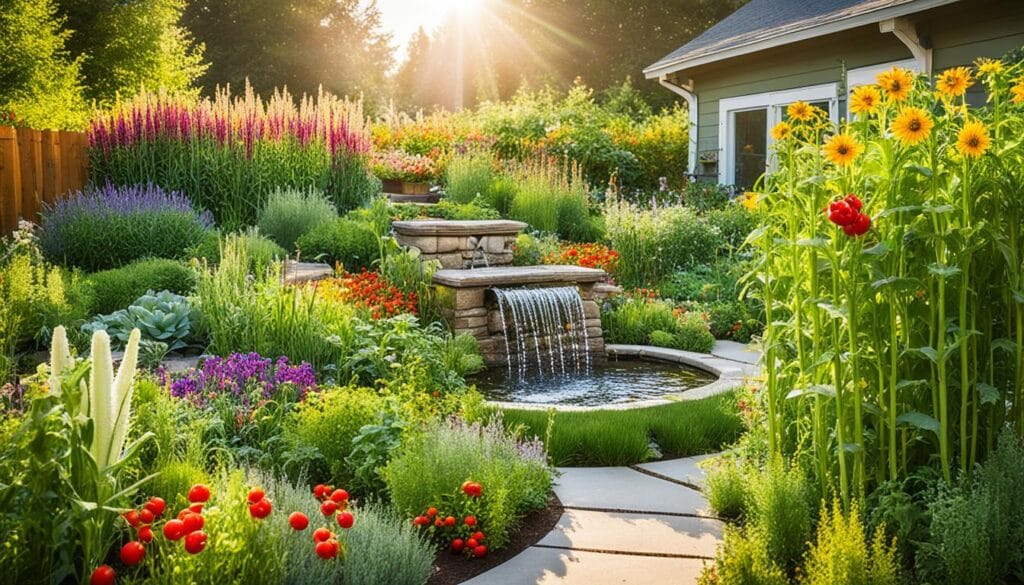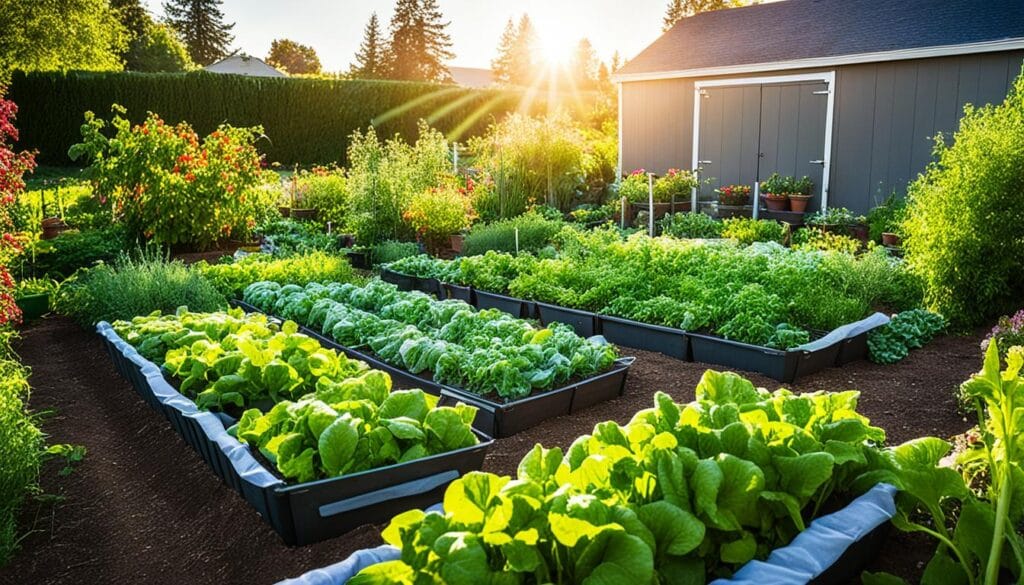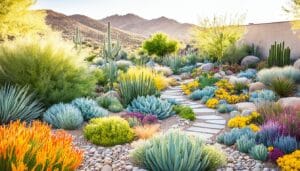Growing a garden at home is rewarding. It connects you to nature, gives you fresh produce, and offers a peaceful escape. This guide will help you make a garden that fits your space and tastes.
Table of Contents

Key Takeaways
- Discover the numerous benefits of home gardening, from growing your own fresh produce to creating a beautiful outdoor oasis.
- Understand the importance of selecting the right location for your garden based on sunlight exposure and soil quality.
- Learn how to prepare the soil and incorporate organic matter to ensure optimal plant growth.
- Explore the joys of cultivating a vegetable garden, a flower garden, or a combination of both.
- Embrace sustainable practices, such as natural pest control and composting, to maintain a healthy and eco-friendly garden.
Introduction to Home Gardening
Gardening at home is a rewarding hobby that brings many benefits for your health and the planet. It lets you grow your own food or create a beautiful garden. This hobby can make your life richer in many ways.
Benefits of Home Gardening
One big plus of home gardening is growing your own fruits and vegetables. These are fresher and taste better than store-bought ones. They also avoid the long transport and processing that can lower their nutritional value. Plus, you can choose how to grow your food, keeping it free from harmful chemicals.
Home gardening is good for your mind and body too. It can reduce stress, boost your mood, and give you a sense of pride as you see your plants grow. Gardening also helps with fitness and heart health through physical activity.
Essential Gardening Tools and Supplies
To start gardening, you need the right tools and supplies. Here are some must-haves:
- High-quality gardening gloves to protect your hands
- A sturdy trowel for digging and moving plants
- A watering can or hose to keep plants watered
- Garden shears or pruning scissors for trimming plants
- Seeds or seedlings for the plants you want to grow
- Nutrient-rich soil or compost for your plants
With the right tools and some knowledge, you can turn your outdoor area into a lush garden. This garden will give you lots of benefits of home gardening, like fresh food and a peaceful space. Whether you’re experienced or new to gardening, the happiness it brings is easy to find.
Choosing the Right Location for Your Garden
Starting a home garden means picking the perfect spot. Look at the sunlight and soil quality to make sure your plants grow well.
Assessing Sunlight Exposure
How much sunlight your garden gets is key to picking the right plants. Most plants need at least 6 hours of sunlight a day. Watch the area during the day to see how much sun it gets.
- Identify areas that receive full sun (6+ hours of direct sunlight per day)
- Locate partially shaded spots that get 3-6 hours of sunlight
- Avoid areas with heavy shade or less than 3 hours of direct sunlight
Considering Soil Quality and Drainage
Soil quality and drainage are crucial for gardening success. You need soil that’s rich in nutrients and drains well. Here’s how to check your soil:
- Examine the texture: Squeeze a handful of soil and see if it clumps or crumbles easily.
- Check the drainage: Dig a small hole and fill it with water. If it doesn’t drain in a few hours, the soil might drain poorly.
- Test the pH level: Use a soil test kit to see if your soil is acidic, neutral, or alkaline, and adjust as needed.
| Soil Quality Characteristic | Ideal Range |
|---|---|
| Soil Texture | Loamy, with a balance of sand, silt, and clay |
| Soil Drainage | Well-draining, allowing water to percolate within a few hours |
| Soil pH | 6.0 to 7.0 (slightly acidic to neutral) |
By looking at the garden location, sunlight exposure, soil quality, and soil drainage, you can make sure your garden is set up for success.

Home Gardening
Home gardening opens up a world full of possibilities. You can create everything from big backyard oases to small urban gardens. No matter the size of your space, the secret to a great garden is to adapt to your environment.
Traditional Home Gardening: If you have a big backyard, you can do a lot with it. You can grow vegetables, flowers, or both. This lets you use your space fully and make a beautiful garden right outside your door.
Urban Gardening: For those living in the city or with little outdoor space, gardening is different. Creative gardeners turn small spots like balconies and windowsills into gardens. They show that home gardening can work even in tiny places.
Container Gardening: Container gardening is a great way to garden at home. You can use pots, planters, and baskets to grow many types of plants. This way, you can have flowers, herbs, or vegetables in even the smallest urban gardening spots.
No matter the size or location of your garden, you can enjoy home gardening. With creativity and the right methods, you can make any space your own garden. It can show off your style and what you like.
“Gardening is a way of showing that you believe in tomorrow.” – Audrey Hepburn
Preparing the Soil for Planting
Starting a home garden begins with the basics. Preparing the soil is key to making sure your plants get the nutrients they need. By focusing on soil preparation, you help your plants grow well.
Composting and Organic Matter
Adding compost and other organic stuff to your soil is a great way to make it better. Composting turns plant and food waste into a soil booster full of nutrients. It helps reduce waste and makes the soil richer and stronger.
Here are some tips for adding compost and organic stuff to your soil:
- Use a mix of materials like leaves, grass clippings, and vegetable scraps for your compost.
- Put in 2-4 inches of compost or organic stuff into the top 6-8 inches of soil.
- Keep adding organic stuff to your soil to keep it full of nutrients and good at holding water.
Putting effort into soil preparation sets the stage for a great home garden. You’ll get lots of food or beautiful flowers.

“The key to a successful garden is healthy soil. By incorporating compost and organic matter, you’re providing your plants with the nutrients and structure they need to thrive.”
Vegetable Gardening: Growing Your Own Produce
Discover the joy of growing your own fresh vegetables at home. Vegetable gardening is a rewarding hobby that lets you grow flavorful, nutrient-dense produce in your backyard. It doesn’t matter if you have a big garden or a small patio. You can easily add vegetable gardening to your life.
Choosing the right vegetables is key for a great harvest. Think about your climate, sunlight, and what you like to eat. You can grow everything from juicy tomatoes and crisp cucumbers to leafy greens and root vegetables.
Planting Techniques for Optimal Growth
Getting your vegetable garden off to a good start is crucial. Make sure your soil is rich in organic matter and has the right pH balance. Know how much space and depth each vegetable needs to grow well. Use smart watering, mulching, and weed control to keep your garden healthy and productive.
Ongoing Care and Maintenance
Looking after your vegetable garden is just as important as planting it. Keep an eye out for pests or diseases and deal with them quickly. Harvesting, pruning, and deadheading on time also help your garden stay healthy and productive.
By following these tips, you can grow your own fresh, organic produce at home. Enjoy the taste of your homegrown vegetables and feel proud of what you’ve grown.

| Vegetable | Sunlight Requirements | Soil Preferences | Planting Time |
|---|---|---|---|
| Tomatoes | Full sun (6-8 hours) | Well-drained, nutrient-rich | Spring/Early Summer |
| Carrots | Full sun (6-8 hours) | Loose, sandy soil | Spring/Early Summer |
| Leafy Greens | Partial shade (4-6 hours) | Nutrient-rich, moist | Spring/Fall |
| Zucchini | Full sun (6-8 hours) | Well-drained, nutrient-rich | Spring/Early Summer |
Flower Gardening: Adding Color and Beauty
Make your outdoor space a vibrant oasis with colorful flowers. Flower gardening is a great way to add beauty and interest to your home. You can choose from the fleeting beauty of annuals or the lasting charm of perennials.
Selecting Annuals and Perennials
Annuals like marigolds, petunias, and zinnias bring color all season long. They bloom once a year, offering quick results for gardeners. Perennials come back every year, providing a dependable and easy garden option.
- Annuals: Marigolds, Petunias, Zinnias
- Perennials: Coneflowers, Lavender, Daylilies
Companion Planting Techniques
Companion planting boosts your garden’s health and beauty. By placing plants together, you create a helpful relationship. For instance, marigolds near vegetables can keep pests away and improve soil.
“Gardening is the art of manipulating nature to suit our tastes. The more we understand the natural world, the better we can create gardens that thrive.”
Knowing about annuals, perennials, and companion planting helps you create a beautiful garden. It also supports a healthy ecosystem.
Container Gardening for Small Spaces
Even if you have a small outdoor area like a balcony or patio, you can still enjoy gardening with container gardening. This method lets you grow veggies, herbs, and flowers in small containers. It’s perfect for city living or small gardens.
Container gardening lets you tailor your garden to your needs and likes. You can pick from many sizes, shapes, and materials for containers. Choose from classic terracotta pots, modern planters, or even old household items.
When picking plants for container gardening, you have many options. You can grow compact tomatoes, space-saving greens, or colorful flowers. Think about what each plant needs to make a beautiful and thriving urban gardening space.
Maximizing Your Container Garden
Here are some tips for a great container gardening experience:
- Pick the right container size for your plants’ adult size.
- Use a good potting mix for containers that drains well and has the right nutrients.
- Add compost to the soil to help plants grow strong.
- Put your containers where they get lots of sunlight and good air flow.
- Water your plants regularly but don’t overwater or underwater them.
- Trim and take care of your plants to keep them looking good and productive.
With creativity and care, your container gardening can turn small spaces into a lush garden. Enjoy the benefits of growing your own food, herbs, and flowers in the city.
Organic Gardening Practices
Using eco-friendly gardening methods is key for a healthy and sustainable garden. Organic gardening cuts down on synthetic chemicals. It helps create a balanced ecosystem in your garden. This section talks about natural ways to control pests, keeping your garden beautiful and safe for the environment.
Natural Pest Control Methods
Organic gardening focuses on natural ways to fight pests and diseases. Instead of using harsh chemicals, you can try different methods to keep insects and diseases away. These include using beneficial insects and homemade organic sprays to protect your garden.
Attracting beneficial insects like ladybugs and lacewings is a good idea. These insects eat pests like aphids and mites. By making your garden a home for these helpful insects, you can naturally keep your plants safe.
FAQ
What are the key benefits of home gardening?
Home gardening lets you grow your own fresh, nutritious food. It also helps the environment, cuts down grocery bills, and boosts your health. Plus, it’s a great way to spend time outdoors.
What are the essential tools and supplies needed for home gardening?
You’ll need good soil, seeds, gloves, trowels, shears, and watering tools. Garden beds or containers are also important.
How do I choose the best location for my home garden?
Look for a spot with lots of sunlight and good soil. It should also drain well. Aim for at least 6 hours of sunlight daily.
What are the different types of home gardening?
You can garden in your backyard, in a small urban space, or on a patio or balcony. The type you pick depends on your space and resources.
How do I prepare the soil for planting?
Start by adding compost to the soil to make it richer and better structured. You might also need to fix the pH levels or drainage.
What are the best vegetables to grow in a home garden?
Great choices for beginners include tomatoes, peppers, leafy greens, beans, carrots, and zucchini. Pick varieties that fit your local climate and garden conditions.
How can I incorporate flowers into my home garden?
Add flowers for color and scent, and to help pollinators. Mix annuals and perennials, and try planting them with vegetables for extra benefits.
What are the best practices for container gardening in small spaces?
Pick the right pots and potting mix, and choose plants that don’t need much space. Water and feed them well to keep them thriving.
How can I use organic gardening practices to control pests and diseases naturally?
Use natural methods like beneficial insects, barriers, and repellents. Avoid chemicals to keep your garden healthy and sustainable.





